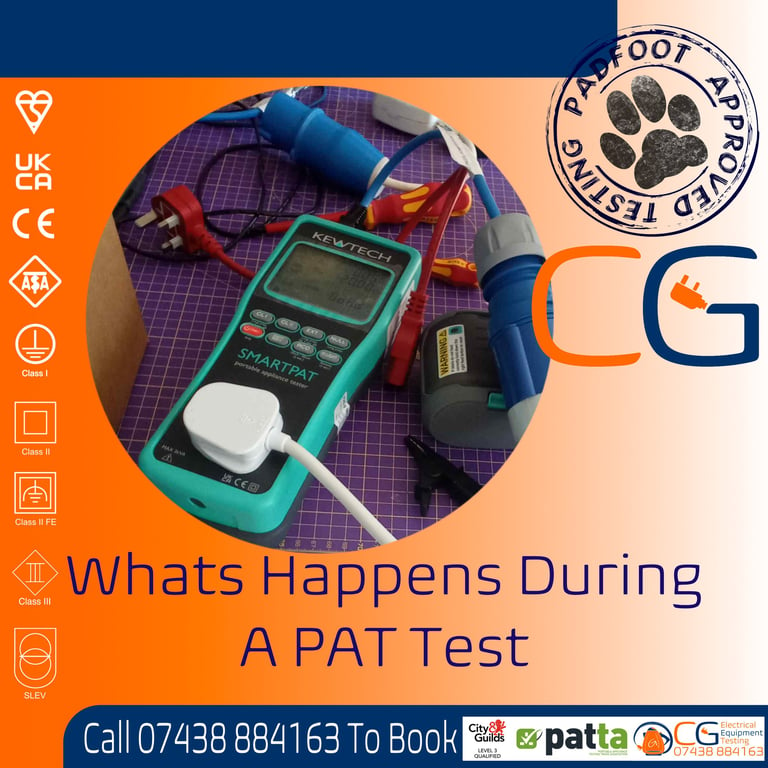What Happens During a PAT Test in the UK – And Why It’s Important
PAT testing in the UK is one of the most effective ways to make sure electrical appliances are safe to use. Whether you’re a business owner, landlord, or simply responsible for workplace safety, understanding the process can help you stay compliant and protect people from harm. In this guide, we’ll explain what happens during a PAT test, why it’s important, and how often you should get it done.
ELECTRICAL SAFETY
8/15/20254 min read


What Happens During a PAT Test in the UK – And Why It’s Important
PAT testing in the UK is one of the most effective ways to make sure electrical appliances are safe to use. Whether you’re a business owner, landlord, or simply responsible for workplace safety, understanding the process can help you stay compliant and protect people from harm.
In this guide, we’ll explain what happens during a PAT test, why it’s important, and how often you should get it done.
What is PAT Testing?
PAT stands for Portable Appliance Testing. It’s the process of checking electrical equipment for safety through a combination of visual inspection and electronic testing.
PAT testing is not a strict legal requirement for all businesses in the UK. However, under the Electricity at Work Regulations 1989, employers, landlords, and duty holders must make sure electrical equipment is maintained in a safe condition. PAT testing is the most recognised way to meet this requirement.
What Happens During a PAT Test?
The PAT testing process has two main stages:
1. Visual Inspection 👀
The tester first examines the appliance for any visible defects. Common issues spotted include:
Frayed or damaged power cables
Cracked or broken plugs
Scorch marks from overheating
Loose or exposed wires
Incorrect or damaged fuses
UKCA or CE Marks
This step alone can identify many faults before any electrical testing begins.
2. Electrical Testing ⚡
Next, the tester uses a PAT testing machine to check the internal safety of the appliance. These tests include:
Earth Continuity Test - Ensures the earth wire is securely connected for safety.
Insulation Resistance Test - Confirms electricity isn’t leaking from the appliance’s wiring.
Polarity Check - Verifies that the wiring inside the plug is correct.
Touch/Leakage Test - to ensure that the current flowing from live parts of an appliance to a grounded or exposed metal surface (like a casing) is at a safe level.
Functional Test - This ensures the appliance is functioning
When the appliance passes, it’s labelled with a PAT test sticker showing the test date, result, and next recommended test date. If it fails, it should be repaired or replaced immediately.
Why PAT Testing is Important
Skipping PAT testing can lead to serious risks, including:
Electrical shocks to users
Electrical fires caused by faulty wiring
Unexpected equipment failure and downtime
Legal liability if someone is injured
By arranging regular PAT testing in the UK, you can prevent accidents, protect employees and tenants, and show proof of compliance with health and safety regulations.
How Often Should You PAT Test?
The frequency depends on the type of appliance, its location, and how often it’s used. Examples include:
High-risk equipment (e.g. power tools on construction sites): every 3–6 months
Medium-risk equipment (e.g. kitchen appliances in commercial settings): annually
Low-risk equipment (e.g. office computers): every 2–4 years
A qualified PAT tester can give tailored advice based on your equipment and environment. However, the decison will always remain with your Duty Holder.
The Bottom Line on PAT Testing in the UK
A PAT test is a quick, cost-effective way to keep electrical appliances safe and compliant. The process includes a thorough visual check and electrical safety test, helping to prevent accidents and reduce liability.
If you’re a UK business owner, landlord, or anyone responsible for workplace safety, scheduling regular PAT testing is one of the simplest ways to protect people and stay within the law.
PAT Testing in the UK: Preventing Workplace Fires and Staying Compliant
Did you know? Regular Portable Appliance Testing (PAT testing) not only helps prevent workplace fires but also keeps your business compliant with UK health and safety regulations.
For many businesses, electrical equipment is used every day—whether it’s computers in an office, kitchen appliances in a café, or power tools on a construction site. But without regular checks, these appliances can become fire hazards. That’s why PAT testing in the UK is so important.
Why PAT Testing is Essential
According to UK Fire and Rescue Service data, up to 20% of workplace fires are caused by faulty electrical appliances. In most cases, these fires could have been prevented with routine electrical safety testing.
PAT testing ensures electrical appliances are safe to use, helping employers reduce fire risks, avoid downtime, and meet their legal responsibilities.
UK Regulations on PAT Testing and Electrical Safety
While there isn’t a single law that explicitly says “you must PAT test,” several UK health and safety laws require businesses to maintain safe electrical systems. PAT testing is the recognised method to prove compliance.
Key legislation includes:
Electricity at Work Regulations 1989 – Employers must ensure electrical systems are maintained to prevent danger.
Health and Safety at Work Act 1974 – Duty of care to protect employees, customers, and the public.
Provision and Use of Work Equipment Regulations 1998 (PUWER) – Requires equipment provided for work to be suitable and safe.
Management of Health and Safety at Work Regulations 1999 – Mandates risk assessments, including those for electrical hazards.
Failing to comply with these laws can result in enforcement notices, fines, and even prosecution.
Real UK Case Studies: PAT Testing in Action
🔥 Case Study 1: Office Fire from Faulty Extension Lead
In 2018, an insurance firm reported a severe office fire traced back to an overloaded extension lead. Routine PAT testing could have identified the fault early, preventing thousands of pounds in damages and business disruption.
🏨 Case Study 2: Hotel Compliance Saves Guests and Reputation
A Manchester hotel carrying out regular PAT testing discovered several faulty kettles and hairdryers. By removing them from service, they prevented potential fire risks, maintained health and safety compliance, and satisfied insurance requirements.
👷 Case Study 3: Construction Site Electric Shock
On a London construction site, a worker was injured due to a faulty power tool. HSE found no PAT testing records, and the employer was fined heavily. The incident highlighted the legal and financial consequences of neglecting electrical testing.
Benefits of Regular PAT Testing for UK Businesses
✅ Fire Prevention – Reduces risk of electrical fires in the workplace.
✅ Compliance Proof – Demonstrates compliance with UK safety regulations.
✅ Protects Employees – Prevents shocks and injuries.
✅ Insurance Coverage – Many insurers require proof of regular PAT testing.
PAT testing in the UK is more than a safety formality—it’s a crucial step in protecting your people, property, and reputation. By identifying faulty appliances early, businesses can prevent workplace fires, stay compliant with health and safety laws, and avoid costly fines or insurance issues.
👉 If you haven’t scheduled PAT testing recently, now is the time to act. It’s a small investment that can save lives, money, and your business.
Reliable appliance testing across South Wales.
© 2025. All rights reserved.






